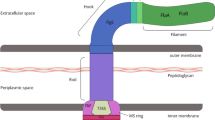Abstract
THE Gram-negative bacterial pathogen Shigella flexneri causes dysentery by invading the human colonic mucosa1. Bacteria are phagocytosed by enterocytes2, escape from the phagosome into the cytoplasm3 and spread to adjacent cells4. After crossing the epithelium, Shigella reaches the lamina propria of intestinal villi, the first line of defence. This tissue is densely populated with phagocytes that are killed in great numbers, resulting in abscesses5,6. The genes required for cell invasion7 and macrophage killing2 are located on a 220-kilobase plasmid. We report here on the mechanism of cytotoxicity used by S. flexneri to kill macrophages. Each of four different strains was tested for its capacity to induce cell death. An invasive strain induced programmed cell death (apoptosis8,9), whereas its non-invasive, plasmid-cured isogenic strain was not toxic; neither was a mutant in ipa B (ref. 10) (invasion protein antigen), a gene necessary for entry. A non-invasive strain expressing the haemolysin operon of Escherichia coli11 induced accidental cell death (necrosis), demonstrating that other bacterial cytotoxic mechanisms do not lead to apoptosis. This is the first evidence that an invasive bacterial pathogen can induce suicide in its host cells.
Similar content being viewed by others
References
LaBrec, E. H., Schneider, H. Magnani, T. J. & Formal, S. B. J. Bact. 88, 1503–1518 (1964)
Clerc, P. L. Ryter, A., Mounier, J. & Sansonetti, P. J. Infect. Immun. 55, 521–527 (1987).
Sansonetti, P. J., Ryter, A. Clerc, P., Maurelli, A. T. & Mounier, J. Infect. Immun. 51, 461–469 (1986).
Bernardini, M. L. Mounier, J., d'Hauteville, H., Coquis-Rondon, M. & Sansonetti, P. J. Proc. natn. Acad. Sci. U.S.A. 86, 3867–3871 (1989).
Anand, B. S. et al. Gastroenterology 90, 654–660 (1986).
Mathan, M. M. & Mathan, V. I. Rev. infect. Dis. 13 (suppl. 4), 314–318 (1991).
Sansonetti, P. J., Kopecko, D. J. & Formal, S. B. Infect. Immun. 35, 852–860 (1982).
Arends, M. J. & Wyllie, A. H. Int. Rev. exp. Path. 32, 223–254 (1991).
Ellis, R. E., Yuan, J. & Horvitz, H. R. A. Rev. Cell Biol. 7, 663–698 (1991).
High, N., Mounier, J. Prevost, M. C. & Sansonetti, P. J. EMBO J. 11, 1991–1999 (1992).
Noegel, A., Rdest, U., Springer, W. & Goebel, W. Molec. Gen. Genet. 175, 343–350 (1979).
Zheng, L. M., Zychlinsky, A., Liu, C.-C., Ojcius, D. M. & Ding-E Young, J. J. Cell Biol. 112, 279–288 (1991).
Tanenbaum, S. W. Cytochalasin: Biochemical and Cell Biological Aspects (North-Holland, Amsterdam, 1978).
Welch, R. A. Molec. Microbiol. 5, 521–528 (1991).
Mangan, D. F., Welch, G. R. & Wahl, S. M. J. Immun. 146, 1541–1546 (1991).
Gaillard, J. L. Berche, P., Mounier, J., Richard, S. & Sansonetti, P. J. Infect. Immun. 55, 2822–2829 (1987).
Tilney, L. G. & Portnoy, D. A. J. Cell Biol. 109, 1597–1608 (1989).
Waring, P. J. biol. Chem. 265, 14476–14480 (1990).
Author information
Authors and Affiliations
Rights and permissions
About this article
Cite this article
Zychlinsky, A., Prevost, M. & Sansonetti, P. Shigella flexneri induces apoptosis in infected macrophages. Nature 358, 167–169 (1992). https://doi.org/10.1038/358167a0
Received:
Accepted:
Issue Date:
DOI: https://doi.org/10.1038/358167a0
- Springer Nature Limited
This article is cited by
-
Pyroptosis: a double-edged sword in lung cancer and other respiratory diseases
Cell Communication and Signaling (2024)
-
Preparation and characterization of monoclonal antibodies against porcine gasdermin D protein
Applied Microbiology and Biotechnology (2024)
-
High pyroptosis activity in pancreatic adenocarcinoma: poor prognosis and oxaliplatin resistance
Apoptosis (2024)
-
The role of pyroptosis and gasdermin family in tumor progression and immune microenvironment
Experimental Hematology & Oncology (2023)
-
Maresin1 alleviates liver ischemia/reperfusion injury by reducing liver macrophage pyroptosis
Journal of Translational Medicine (2023)





